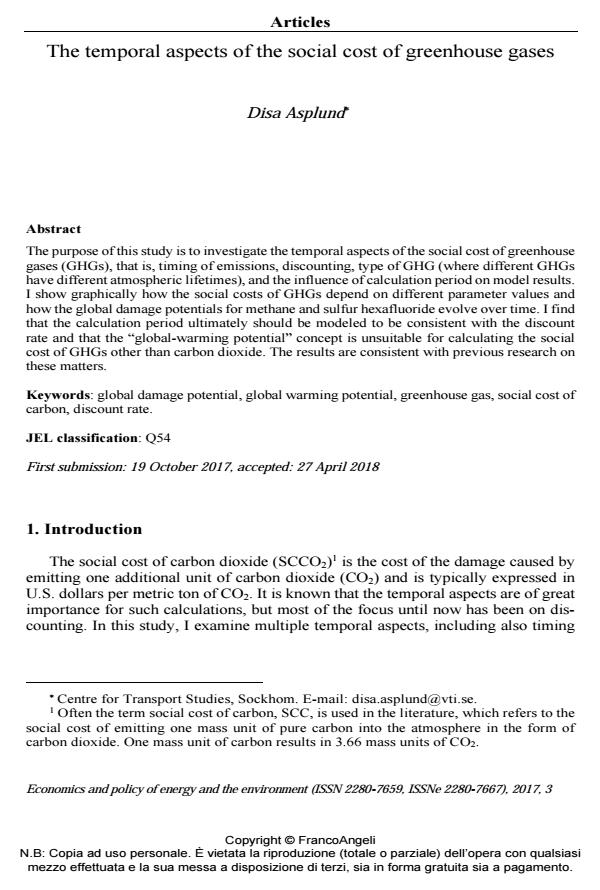The temporal aspects of the social cost of greenhouse gases
Titolo Rivista ECONOMICS AND POLICY OF ENERGY AND THE ENVIRONMENT
Autori/Curatori Disa Asplund
Anno di pubblicazione 2018 Fascicolo 2017/3 Lingua Inglese
Numero pagine 15 P. 25-39 Dimensione file 317 KB
DOI 10.3280/EFE2017-003002
Il DOI è il codice a barre della proprietà intellettuale: per saperne di più
clicca qui
Qui sotto puoi vedere in anteprima la prima pagina di questo articolo.
Se questo articolo ti interessa, lo puoi acquistare (e scaricare in formato pdf) seguendo le facili indicazioni per acquistare il download credit. Acquista Download Credits per scaricare questo Articolo in formato PDF

FrancoAngeli è membro della Publishers International Linking Association, Inc (PILA)associazione indipendente e non profit per facilitare (attraverso i servizi tecnologici implementati da CrossRef.org) l’accesso degli studiosi ai contenuti digitali nelle pubblicazioni professionali e scientifiche
The purpose of this study is to investigate the temporal aspects of the social cost of greenhouse gases (GHGs), that is, timing of emissions, discounting, type of GHG (where different GHGs have different atmospheric lifetimes), and the influence of calculation period on model results. I show graphically how the social costs of GHGs depend on different parameter values and how the global damage potentials for methane and sulfur hexafluoride evolve over time. I find that the calculation period ultimately should be modeled to be consistent with the discount rate and that the "global-warming potential" concept is unsuitable for calculating the social cost of GHGs other than carbon dioxide. The results are consistent with previous research on these matters.
Keywords:Global damage potential, global warming potential, greenhouse gas, social cost of carbon, discount rate.
Jel codes:Q54
- Ahlberg J. et al. (2017). Marginalkostnad för luftfartens infrastruktur, VTI rapport 959, revised version 1, ISSN: 0347-6030 -- http://vti.diva-portal.org/smash/get/diva2: 1168852/FULLTEXT02.pdf.
- Anthoff D., Tol R.S.J., Yohe G.W. (2009). Risk aversion, time preference, and the social cost of carbon. Environmental Research Letters, 4.
- Azar C., Johansson D.J.A. (2012). Valuing the non-CO2 climate impacts of aviation. Climatic Change, 111: 559-579.
- Baum S. (2009). Description, prescription and the choice of discount rates. Ecological Economics, 69: 197-205.
- Dasgupta P. (2008). Discounting climate change. Journal of Risk and Uncertainty, 37: 141-169.
- Dietz S., Anderson D., Stern N., Taylor C., Zenghelis D. (2007). Right for the right reasons: a final rejoinder on the Stern Review. World Economics, 8(2). Eyre N., Downing T., Hoekstra R., Rennings K. (1999). Global Warming Damages. Final Report of the ExternE Global Warming Sub-task. DGXII, EC, Brussels -- http://www.externe.info/.
- Evans D. (2005). The elasticity of marginal utility of consumption: estimates for 20 OECD countries. Fiscal Studies, 26(2): 197-224.
- Gollier C. (2010). Expected Net Present Value, Expected Net Future Value, and the Ramsey Rule. Journal of Environmental Economics and Management, 59(2): 142-148.
- Guo J., Hepburn C.J., Tol R.S.J., Anthoff D. (2006). Discounting and the social cost of carbon: a closer look at uncertainty. Environmental Science & Policy, 9: 205-216.
- Hammitt J.K., Jain A.K., Adams J.L., Wuebbles D.J. (1996). A welfare-based index for assessing environmental effects of greenhouse-gas emissions. Nature, 381: 301-303.
- Hope C. (2005). The climate change benefits of reducing methane emissions. Climatic Change, 68: 21-39.
- Hope C. (2006). The marginal impact of CO2 from PAGE2002: an integrated assessment model incorporating the IPCC’s Five Reasons for Concern. The Integrated Assessment Journal, 6(1): 19-56. I assume “Five Reasons for Concern” is the title of an IPCC document. If not, please make those words lowercase.
- Hope C. (2008a). Discount rates, equity weights and the social cost of carbon. Energy Economics, 30: 1011-1019.
- Hope C. (2008b). Optimal carbon emissions and the social cost of carbon over time under uncertainty. The Integrated Assessment Journal, 8(1): 107-122.
- Intergovernmental Panel on Climate Change, IPCC (2000). Emissions Scenarios. Cambridge, UK: Cambridge University Press.
- Intergovernmental Panel on Climate Change, IPCC (2001). IPCC Third Assessment Report: Climate Change 2001 (TAR): The Scientific Basis. Cambridge, UK: Cambridge University Press.
- Intergovernmental Panel on Climate Change, IPCC (2007). “The Physical Science Basis”. Ch. 2.10.2 of IPCC Fourth Assessment Report: Climate Change 2007 (AR4), Working Group I Report. Cambridge, UK: Cambridge University Press.
- Köbberling V. (2006). Strength of preference and cardinal utility. Economic Theory, 27: 375-391.
- Marten A.L., Newbold S.C. (2012). Estimating the social cost of non-CO2 GHG emissions: methane and nitrous oxide. Energy Policy, 51: 957-972 -- http://www.sciencedirect.com/science/article/pii/S0301421512008555.
- Nordhaus W., Boyer J. (2000). Warming the World: Economic Models of Global Warming.The MIT Press, Cambridge, MA.
- Schmalensee R. (1993). Comparing greenhouse gases for policy purposes. The Energy Journal, 14: 245-255.
- Stern N. (2006). The Economics of Climate Change: The Stern Review. Cambridge University Press, Cambridge, UK.
- Thureson D. (2012). Avoiding path dependence of distributional weights: Lessons from climate change economic assessment. Working Papers, School of Business, Örebro University No 2012:8 -- http://swopec.hhs.se/oruesi/abs/oruesi2012_008.htm.
- Trafikverket (2016). “Kostnad för klimateffekter.” Analysmetod och samhällsekonomiska kalkylvärden för transportsektorn: ASEK 6.0, ch. 12, version 2016-04-01, Swedish Transport Administration -- https://www.trafikverket.se/contentassets/4b1c1005597d47bda386d81dd3444b24/12_klimateffekter_a60.pdf
- Waldhoff S., Anthoff D., Rose S., Tol R.S.J. (2014). The marginal damage costs of different greenhouse gases: an application of FUND. Economics: The Open-Access, Open-Assessment E-Journal, 8.
- Weitzman M.L. (2009). On modeling and interpreting the economics of catastrophic climate change. The Review of Economics and Statistics, XCI(1).
- Wigley T., Raper S. (1992). Implications for climate and sea level of revised IPCC emissions scenarios. Nature, 357: 293-300.
- Wigley T. (2005). The climate change commitment. Science, 307(5716): 1766-1769.
- Yngström Wänn S. (2017). Trafikslagsövergripande plan för utveckling av metoder, modeler och verktyg – för analys av samhällsekonomi, järnvägskapacitet, effektsamband och statistik samt för trafik- och transportprognoser. Trafikverket rapport 2017:087, version 1.1.
- 온실가스 감축을 위한 국제사회의 탄소가격제 도입과 경제영향 분석 (Global Application and Economic Analysis of Carbon Pricing for Emissions Reduction) Jin-Young Moon, Minsoo Han, Jihei Song, Eunmi Kim, in SSRN Electronic Journal /2017
DOI: 10.2139/ssrn.3299911
Disa Asplund, The temporal aspects of the social cost of greenhouse gases in "ECONOMICS AND POLICY OF ENERGY AND THE ENVIRONMENT" 3/2017, pp 25-39, DOI: 10.3280/EFE2017-003002